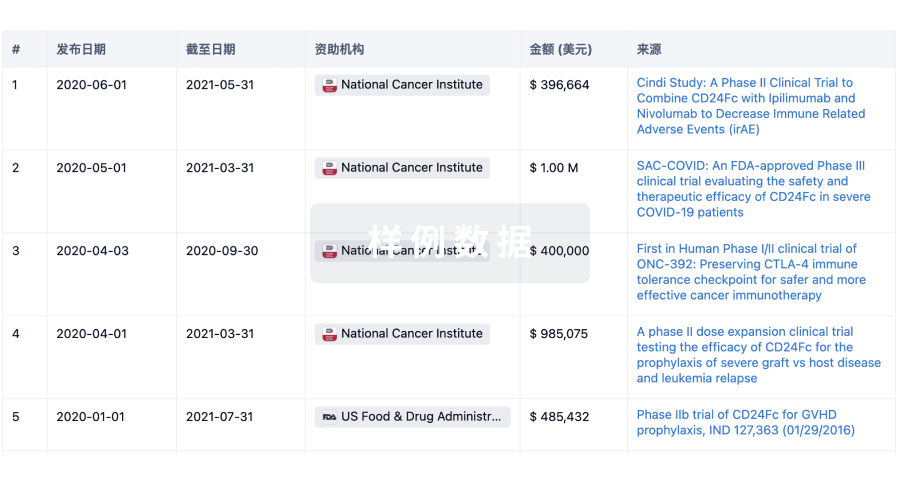预约演示
更新于:2025-05-07
Insight Medtech Co., Ltd.
深圳北芯医疗科技有限公司|私营公司|2020|中国广东省
深圳北芯医疗科技有限公司|私营公司|2020|中国广东省
更新于:2025-05-07
概览
关联
1
项与 深圳北芯医疗科技有限公司 相关的临床试验NCT06014996
A Prospective, Multicenter, Randomized Controlled Trial of the Irreversible Electroporation-based Pulsed Field Ablation Versus Radiofrequency Ablation for Symptomatic Paroxysmal Atrial Fibrillation.
This study is a mulitcentre, randomized, parallel-group evaluation of pulse field ablation(PFA) and radiofrequency ablation(RFA) in patients being treated for symptomatic paroxysmal AF.
Pulmonary-vein isolation (PVI) is the primary intention of catheter ablation in both groups.
Pulmonary-vein isolation (PVI) is the primary intention of catheter ablation in both groups.
开始日期2023-09-04 |
申办/合作机构 深圳北芯医疗科技有限公司 [+8] |
100 项与 深圳北芯医疗科技有限公司 相关的临床结果
登录后查看更多信息
0 项与 深圳北芯医疗科技有限公司 相关的专利(医药)
登录后查看更多信息
1
项与 深圳北芯医疗科技有限公司 相关的文献(医药)2023-12-28·Europace
‘Single-shot’ pulmonary vein isolation using a novel lotos pulsed field ablation catheter: a pre-clinical evaluation of feasibility, safety, and 30-day efficacy
Article
作者: Liu, Huiyi ; Lin, Weidong ; Chen, Yuhan ; Liu, Fangzhou ; Pu, Sijia ; Chen, Yanlin ; Wu, Shulin ; Fu, Lu ; Li, Peng ; Luo, Cihua ; Ye, Xingdong ; Xue, Yumei
15
项与 深圳北芯医疗科技有限公司 相关的新闻(医药)2025-04-10
·健识局
近日,深圳北芯生命科技股份有限公司更新了在科创板的招股说明书。北芯生命成立于2015年,主要开发冠脉介入相关的产品。传统的“放支架”通常在造影的指导下进行,难以精准评估血管内部结构。精准经皮冠状动脉介入治疗(PCI)就可以更好的辅助医生进行手术。心血管精准诊疗包括血流储备分数(FFR)、血管内超声成像(IVUS)和光学相干断层扫描(OCT)几种技术,北芯生命主要做的是血管超声成像和血流储备。这一领域市场长期由雅培诊断、波士顿科学、飞利浦几家进口厂商垄断。国内企业中北芯生命、乐普医疗、开立医疗等也有自己的产品。截至去年,北芯生命有9款产品商业化,2024年营收达到3.17亿元,核心贡献来自于精准冠脉介入辅助产品。血管内超声成像导管、血流储备功能检查压力微导管占据了公司超90%以上的收入。图源:北芯生命招股说明书虽然已经有了收入,北芯生命并未摆脱亏损的局面,毕竟大多数产品还处于市场早期。2022-2024年,北芯生命累计亏损超5亿元,去年亏损有所收窄,仍有5373万元。眼下的北芯生命急需资金续命。靠集采翻身北芯生命已经不是第一次筹划IPO。2021年,北芯生命曾向港交所谋求上市,但最终未果。2023年3月,北芯生命转战上交所科创板,受理后至今都没得到上会通过。当时公司的两大产品血流储备分数测量系统、血管超声系统都已经获批上市,而且实现了不错的销售:2021年,血流储备分数测量系统上市第二年就占据了国内市场份额的30.6%,仅次于雅培诊断;2022-2024年,血流储备分数系统每年都能拿到约8000万元的收入。血管超声系统的壁垒却没有那么容易攻破。北芯生命的血管超声系统产品2022年上市,收入主要来源于导管的销售,2023年这一系列产品的收入就达到了9708万元,算是国内企业中市占率最高的。但和外资一比就小巫见大巫了:2023年,北芯生命的血管超声业务市占率只有5%,远不及波士顿科学、飞利浦等。集采的到来,给了北芯生命喘息的机会。2023年,浙江省牵头启动冠状血管内超声诊断导管的省际联盟采购,规模近乎于国家集采,平均降幅53%,北芯生命成功中选。从去年业绩来看,集采帮了大忙。2024年,北芯生命的血管超声类产品销量翻了3倍,销售收入则增加了约124%,达到2.17亿元。公司的净亏损因此有了大幅缩减,经营性现金流净额也终于扭正。可以说,2024年已经是目前北芯生命表现最好的一年,也是北芯生命最接近上市的一次。腹背受敌北芯生命此时寻求上市,可能也是迫于对赌协议的压力。没有商业化产品上市之前,北芯生命一直仰赖着资本输入支撑创新医疗器械的开发,吸引了红杉铭盛、太平医疗、国投创合等诸多知名机构。2016至2022年,北芯生命共进行七轮融资,估值从5400万元迅速膨胀到53.2亿元。北芯生命与诸多投资方达成了对赌协议,赌的是北芯生命在2024年12月31日前能不能顺利IPO。失败的话,投资方不仅要拿回本金,还要收取本金年化12%的复利。此时更新的招股说明书,很可能相关对赌延期,北芯生命在寻求最后一次“续命”的机会。单就市场空间而言,精准PCI的未来其实是可观的。我国是心血管疾病大国,心血管病人就高达3.3亿人,冠脉疾病是最常见的心脏病类型。人口老龄化以及冠脉手术普及的提升,血管超声等精准诊断手段的应用会越来越高。而我国精准PCI的渗透率较低,其中,中国血管超声在冠状动脉手术中的渗透率仅在15.4%,日韩则已经超过了90%。北芯生命等国产厂商最大的难关,其实在于挑战外资企业的市场地位。2024年落地的浙江联盟集采中,外资企业在报量上就占据了绝对优势,波士顿科学首年采购需求量总计23万根,占总需求量近八成。创新医疗器械不比仿制药,产品尚处于商业化早期,北芯生命很难做到像药品那样,用价格来突破重围。从集采报价中就能看出,国产厂商并没有在价格上形成优势,与进口厂商的报价维持在了同一水平线。图源:广东省医保局 国内的竞争对手也不容小觑。国产厂家恒宇医疗、开立医疗、全景恒升,以及远大医药和博动医疗等新一代血管超声、光学相干断层扫描产品均已陆续获批上市,对北芯生命形成合围之势;国产厂家乐普医疗的FFR产品,以及博动医疗等开发的新一代基于影像的FFR产品都已经获批上市,这些将与北芯生命同台竞争。此时的北芯生命,很需要上市。撰稿 | 杨曦霞编辑|江芸 贾亭运营 | 廿十三声明:健识局原创内容,未经许可请勿转载内容如有问题,请邮件联系:jianshiju@boyamedia.com商务咨询:13288688512
IPO带量采购
2024-10-07
·动脉网
房颤发生的主要机制是肺静脉等部位的心房肌的异常电活动。导管消融则是采取不同方式实现肺静脉隔离(PIV),阻断异常信号传导,使心脏回归正常节律,从而达到治疗房颤的目的。房颤是脉冲电场消融(PFA)主要的适应症之一。
在过去二十多年里,射频和冷冻消融是心脏消融领域的主流。但PFA一经出现,依托其消融时间短、治疗效果好、后遗症小等优势成为了“未来十年心脏消融技术的主导”,且在近些年临床和商业化进展迅速。
PFA市场大有可为:波科同期增长125%,美敦力实现中个位数增长
目前,全球获NMPA批准的产品有四款,分别来自锦江电子、德诺电生理、波士顿科学和美敦力;波士顿科学和美敦力则是全球两家同时获得NMPA、FDA、CE和日本监管部门批准治疗房颤的PFA厂商。
波士顿科学旗下的Farapulse是PFA鼻祖。2024年7月,波士顿科学公布2024年二季度财报,得益于Farapulse系统,其电生理业务销售额同期增长了125%,为波士顿科学在心血管领域的发展注入了强劲动力,也给PFA市场的发展带来了极大信心。
美敦力的PulesSelect是全球第一个同时获得CE\FDA\日本监管\NMPA批准的PFA产品。美敦力在8月20日公布的2025财年第一季度财报中提到,心脏消融解决方案业务在PulseSelect脉冲消融系统的推动下,实现了中个位数的增长。
根据弗若斯特沙利文数据,中国PFA市场规模2025年将达到13亿元,并保持快速增长,预计于2032年达到163亿元,期间GAGR为43.73%;PFA市场规模占电生理器械整体市场规模的比重预计也将不断上升,由2025年的8.18%提升至2032年的38.87%。PFA市场大有可为。
全球36款产品百花齐放,适应症扩大、技术实现多维升级
为了了解当前全球PFA产品的发展情况,我们梳理了全球30家企业共36款PFA产品,发现自2023年,全球PFA市场极其热闹,产品在扩大适应症、导管/标测技术升级上都有诸多优秀表现。
需要强调的是,表格内容是由动脉网基于公开信息整理的部分内容,不包含该企业的所有产品线/该产品的所有功能或所有参数,且适应症仅限于电生理领域,不包含脉冲消融肿瘤。
■ 适应症扩大,多家国产企业在持续性房颤有新进展
观察表格产品的适应症可以看到,绝大多数PFA产品的适应症是阵发性房颤。阵发性房颤是指发作后7天内自行或干预终止的房颤,当前占房颤总量的1/3.。从临床上看,若不加以干预,在未来3年中20%以上会进展为持续性房颤。
而持续性房颤的发生和持续机制更复杂,无论是导管消融还是胸腔镜下外科消融对于维持窦性心律都比较困难。
美敦力的PulseSelect是NMPA和FDA批准的首款既适用于阵发性房颤又适用于持续性房颤的PFA产品,这也是美敦力PFA相较其他产品的最大优势。
但其他厂商也未坐以待毙,而是加快了产品适应症的研究速度。根据梳理结果,波士顿科学在今年4启动了FARAVIEW软件模块的相关研究,以治疗阵发性和持续性房颤患者。
国产厂家中,惠泰医疗在2023年3月公告中提到,其磁压力消融系统是国内首款完成持续性房颤上市前临床试验入组的同类产品;锦江电子在2024年3月成功开展了脉冲电场消融治疗持续性房颤的临床研究;心航路医学构建的“磁电三维+磁电PFA”的一体化三维PFA产品组合,也有望成为全球唯一能对持续性房颤进行标测并实现个性化消融的PFA产品组合;9月,剑虎医疗完成首例创新介电三维+纳秒脉冲一体化治疗系统治疗持续性心房颤动临床研究。
■ 消融导管升级:一管多能,电脉冲+射频/冷冻消融出现
完整的PFA产品包括了能量装置、消融导管和标测平台,分别起着产生和控制脉冲电场能量的输出、直接作用于心肌组织、精准定位病灶和评估消融效果的作用。随着消融平台的不断成熟,结合了多种技术优势的双能/多能量平台成为研发新趋势,各种创新产品纷纷出现。
一管双能技术则是指在同一根消融导管中集成多种能量形式,特别是脉冲电场与射频/冷冻能量的结合,以实现更高效、更安全的消融效果。
目前,强生的Thermocool SmartTouch SFF双能量导管,能够在射频和脉冲电场能量之间切换,同时具备射频消融和脉冲电场的双消融能力;美敦力Sphere-9晶格消融导管搭配HexaGen消融仪和盐水灌注泵使用,兼具射频消融和脉冲消融 ,且无需移动导管和连接线,能够满足不同部位的消融需求;美国Adagio的脉冲冷冻消融(PFCA)技术,将脉冲电场和冷冻消融技术结合,使用同一导管提供超低温冷冻消融和脉冲消融。
但一管双能技术还面临着不同能量的输出控制和稳定性、导管工艺设计和制造、安全防护和可靠性保障等技术难点,当前市场尚未出现较成熟的相关产品。
同时,还有一些国产企业将脉冲消融与标测功能高度集成,通过一根或多根特殊设计的导管即可实现心脏组织的三维建模、电生理标测、脉冲消融及消融效果评估等全流程操作。这种一体化设计能够提高手术精准性和安全性,提高治疗效果和缩短手术时间等。
根据公开资料,波士顿科学、美敦力、加拿大Kardium、锦江电子、德诺电生理、惠泰医疗、心航路医学都拥有兼具脉冲消融和标测功能的PFA产品。
■ 标测技术升级:AI重建左心房解剖结构、首例介电三维手术成功开展
标测系统是医生追踪疾病来源、指定消融方案的重要工具。根据标测技术的不同,可以分为二维标测和三维标测。三维磁电定位技术具备建模准确、定位导航精准度高和可视化程度高的优势,可有效解决二维X光透视辐射伤害较大的痛点。根据动脉网分析,全球三维电生理手术已全面取代二维,手术量占比超过80%。
三维系统早期定位方式为磁定位和电定位,都具有高精确度,可以实现实时导航,使导管可视化,帮助医生进行导航和决策。但磁定位对磁场干扰敏感度高,需要在无外部磁场干扰的环境下进行操作,而电定位可能受血流影响,因此,三维系统逐渐将两者融合成磁电双定位系统,提高定位模型准确性,并确保导管定位的准确性和可视化效果。
强生的磁电双定位标测系统Carto 3是一种利用电磁技术生成患者心脏结构的实时地图,自2009年面世以来便成为电生理标测领域的标杆,也被视作是强生未来在PFA领域战胜其它对手的最大优势。15年间,强生不断对其升级,以扩大优势。今年5月,强生发布第8次升级版本“CARTO 3 V8”,首次利用AI重建左心房解剖结构,医生无需手动绘制轮廓,提高手术工作流程的效率和地图精度。
当前,锦江电子、艾科脉、惠泰医疗、商阳医疗的PFA产品都具有磁电双定位功能。同时,也有一些企业在研发创新技术,力图赶超。
剑虎医疗研发的三维介电标测技术,未采用主流的磁电双定位/磁电融合技术,而是通过测量跟踪人体内不同类型组织细胞在电场作用下不同介电常数的改变,实现人体组织结构的实时三维高精度定位成像。2024年,该公司旗下的Star Trek介电三维标测+纳秒级脉冲消融一体化系统,在5月完成了该系统全国首例药物难治性阵发性房颤的介入手术治疗,在9月完成了治疗持续性心房颤动临床研究。
心航路医学率先提出了“心脏四维标测系统”DePolar标测系统,其最大特点在于,首次将磁电定位接触式标测技术和磁电定位非接触式标测技术在技术开发和临床应用层面都实现了无缝衔接,形成了统一的标测架构。这一系统在7月完成了入组。
■ 脉冲技术升级:已发展到第三代,国产纳秒脉冲取得突破性进展
脉冲电场技术发展至今,已有三代技术,即一代毫秒脉冲,利用可逆电穿孔效应用于基因转染、电穿孔给药、电化学疗法等;二代微秒脉冲,利用不可逆电穿孔效应用于肿瘤、房颤等心律失常疾病的消融治疗;三代纳秒脉冲,利用超电穿孔效应,用于肿瘤、心血管、呼吸介入、内镜介入等腔内治疗。
纳秒脉冲具有高效率和低刺激性特点,能够解决现有PFA技术对麻醉要求高、肌肉收缩和患者疼痛感等问题,使PFA房颤消融手术更高效、安全。
根据公开资料梳理,当前全球拥有纳秒脉冲心脏消融产品的企业包括了Pulse Biosciences、迈微医疗、北芯医疗和剑虎医疗、睿笛生物。
今年7月,Pulse Biosciences的CellFX纳秒多电极脉冲消融导管在7月获得FDA突破性设备认定;北芯医疗的Lotos PFA心脏脉冲电场消融系统也完成了首例临床入组;剑虎医疗纳秒PFA一体化心脏消融系统在9月完成了治疗持续性心房颤动临床研究;迈微医疗的nsPFA纳秒脉冲电场消融系统早在2023年8月就完成了临床入组。
可以预见,中国的PFA市场将在未来将迎来异常激烈的市场竞争。而在各方势力角逐下,最终的受益者还是患者。
*封面图片来源:123rf
如果您认同文章中的观点、信息,或想进一步讨论,请与我们联系;也可加入动脉网行业社群,结交更多志同道合的好友。
近
期
推
荐
声明:动脉网所刊载内容之知识产权为动脉网及相关权利人专属所有或持有。未经许可,禁止进行转载、摘编、复制及建立镜像等任何使用。
动脉网,未来医疗服务平台
财报
2024-04-13
·动脉网
今年,最火热的赛道或许已经提前确定了。2024年初,国内“医疗器械一哥”迈瑞医疗宣布使用66.52亿元自有资金收购惠泰医疗21.12%的股权,成为惠泰医疗第一大股东及控股股东。4月初,跨国巨头强生宣布与心血管介入领域企业Shockwave达成协议,将以每股335美元的价格收购Shockwave所有流通股,交易总价值约为131亿美元。本次交易已经得到双方董事会批准。根据往年经验,66.52亿元人民币的并购案足以预定2024年国内最大医疗器械并购案;131亿美元的交易金额也足以预定2024年全球TOP3,甚至是全球最大医疗器械并购案。巧合的是,这两个并购标的均是心血管赛道企业。惠泰医疗是国内电生理和血管介入耗材领域的领先企业,曾推出国内首个电生理电极导管、可控射频消融导管、漂浮临时起搏电极导管。Shockwave是全球心血管领域的知名创新企业,其推出的产品Intravascular lithotripsy(简称IVL)是全球首款冠脉血管内冲击波系统,用于解决冠状动脉钙化病变难题。此后,Shockwave还推出了适用于外周动脉钙化的血管内冲击波系统。心血管赛道为何受到国内外器械巨头的一致看重?他们在心血管领域有怎样的战略布局与前瞻性观点?巨资入场,心血管赛道将迎来怎样的变局?131亿美元换一家年销售额超10亿美元的公司,值不值?先来说说近期发生的Shockwave并购案。强生不是Shockwave的第一追求者。事实上,2023年4月,就有传言称波士顿科学在考虑收购Shockwave。但在一个月后,有媒体称Shockwave与波士顿科学的谈判遇到障碍,已经陷入停滞。原因是双方无法就价格达成一致。既然价格谈不拢,Shockwave表示:再等一等。而波士顿科学在与Shockwave谈判收购事宜时,Shockwave也没有停下发展的脚步,其也在与Neovasc公司聊收购。波士顿科学失败了,Shockwave却成功了:2023年4月,Shockwave宣布以1.47亿美元收购Neovasc公司,Neovasc是一家心血管领域创新公司,其产品包括二尖瓣瓣膜和心绞痛的介入治疗器械。在波士顿科学与Shockwave谈判破裂的消息传出之际,市场上又出现了美敦力和强生有兴趣收购Shockwave的传闻。所以说,优质的项目无需着急,应该等一等,后面还有更多追求者,出更高价。市场会相信这些并购传闻吗?答案是肯定的。在美国,医疗行业界这些年的收购传闻,一部分被说是谣言,但另一部分已经成为现实。就如本次强生收购Shockwave,《华尔街日报》在双方官宣前10天就已披露:强生公司计划通过收购Shockwave以提升在心血管设备市场的影响力。若谈判不破裂,强生与Shockwave之间的交易可能在几周内完成。消息泄露之后,Shockwave的股价上涨逾11%,至每股320.46美元。当时,媒体还透露,Shockwave可能会收到其他收购要约。有其他媒体的消息称意向收购者包括美敦力与波士顿科学。4月5日,Shockwave收购传闻终于尘埃落定。正如市场之前传言的那样:强生和Shockwave共同宣布,强生将以每股335美元的价格收购Shockwave所有流通股,较前一天收盘价溢价4.7%;较消息泄露前的3月25日,溢价16%。该交易得到了两家公司董事会的批准,预计将于2024年年中完成。这次并购,强生击败了第一个追求Shockwave的波士顿科学,并击败了只在传闻中出现的美敦力。击败的原因十分简单,强生选择加钱。背后的含义却不简单,强生为什么宁愿加钱也要拿下Shockwave?强生心甘情愿加钱收购,是因为Shockwave能赚来更多的钱。其在新闻稿中表示:Shockwave有望成为强生医疗技术部门的第13个优先平台,年销售额至少为10亿美元。另外,根据并购协议,交易完成后,Shockwave将作为强生医疗技术公司的一个业务部门运营,财务将在心血管产品组合中报告。人员变动方面,强生计划旗下Abiomed公司的全球心脏康复负责人Michael Bodner同时负责Shockwave业务,Shockwave原本的总裁兼COO Isaac Zacharias调整为Shockwave全球总裁,向Michael Bodner汇报。Shockwave原CEO Doug Godshall将在整个过渡过程中提供建议。 300亿美元押注心血管,强生在赌怎样的未来?最近几年,强生在加大心血管领域布局。2022年11月,强生以166亿美元收购人工心脏领域领导者Abiomed。这一收购也是2022年全球医疗器械行业最大并购案。随着收购完成,强生在心血管领域尤其是结构心领域,明显增强了话语权。不过,收购只是强生布局的第一步。Abiomed是人工心脏领域龙头,其Impella系列产品主要用于治疗心源性休克和辅助高危性PCI。2022财年,Abiomed实现收入10.3 亿美元,同比增长22%。其中,Impella系列产品收入9.85亿美元,占总营收的比例超过95%。区域方面,Abiomed超过80%的收入都来自美国市场。Abiomed被收购后,一方面,强生开始扩展Impella系列产品的销售范围,将Impella在全球市场推广。另一方面,强生继续支持Abiomed创新技术,加快研发创新产品。在强生的资源赋能下,Abiomed依靠Impella系列产品在2023年实现营收13.06亿美元,同比增长32.6%。强生在最新年报中表示:2023财年,医疗科技部门的销售额为304亿美元,同比增长10.8%。其中,外科业务销售额为100.37亿美元,同比增长3.6%;骨科业务销售额为89.42亿美元,同比增长4.1%;介入方案(心血管器械业务)销售额为63.50亿美元,同比增长47.70%;视力业务销售额为50.72亿美元,同比增长4.6%。除了强势进军人工心脏细分市场,强生还在2023年11月以4亿美元的预付款收购了左心耳闭合装置公司Laminar,进一步加强其结构性心脏病领域的布局。据了解,强生还将根据Laminar被收购后在临床和监管上的表现支付额外的里程碑付款。强生表示:“Laminar的创新方法会在这个高增长的市场中扩充我们的产品组合,加强我们的电生理学和超声心动图业务。”通过收购与资源赋能,强生2023年心血管器械业务营收63.5亿美元,同比增长49.8%。值得一提的是,2023年强生心血管器械业务营收超越爱德华,成长为全球第四大心血管器械巨头。同时,在全球五大心血管医疗器械巨头中,强生2023年的心血管器械业务增速排名第一,且断崖式领跑。其中,强生增速47.7%,波士顿科学增速12%,爱德华增速12%,雅培增速10%,美敦力增速1%。数据来源,各企业财报2024年,强生继续加码心血管领域。4月,强生宣布收购Shockwave。本次收购,是将强生的心血管产品组合扩展到高增长的血管内钙化市场。在临床上流传着一句话:天不怕,地不怕,就怕血管有钙化。这是因为血管钙化问题极难处理。而Shockwave创新的血管内冲击波技术(IVL)就可处理冠状动脉和外周动脉的钙化问题。强生表示:此次收购将提升公司在心脏康复、电生理领域的竞争力,使公司成为心血管器械领域四个高增长市场的领导者。之所以说本次收购将提升公司的整体竞争力,是因为Shockwave将与其他业务产生协同效应,刺激增长。具体来说,Shockwave的IVL平台与Abiomed的心脏泵平台在复杂PCI(经皮冠脉介入)手术中均起着关键作用,IVL用于大约30%的高风险PCI病例,而这些病例也使用Impella 。例如,不久前,首都医科大学附属北京安贞医院周玉杰教授及团队就曾在心岭迈德研发的Ventiflow LP经导管左心室心脏泵支持下进行PCI手术,并在术中将震波球囊(冲击波球囊)置入血管病变处反复多次扩张,之后顺利置入支架,开通狭窄冠脉。另外,就像此前的Impella系列产品一样,目前的IVL渗透率也处较低水平。收购之后,强生将通过丰富的渠道资源,快速在全球范围内推广IVL,并依靠产品的性能、优势和强生品牌加快应用,提升营收与利润。强生表示:“这笔交易为公司提供了一个需求未被满足且处于高增长中的市场,将给公司带来极具吸引力的增速和利润率。预计这次并购将加速公司的收入增长。”从2022年11月到现在,强生已经投入约300亿美元,加强心血管领域的布局。截至目前,强生在心血管领域已经布局了介入式人工心脏、电生理、左心耳封堵器、血管钙化四大高增长市场。根据强生发布的新闻稿,其希望成为心血管领域四大细分市场的领导者。巨资入场,技术突破,心血管市场的未来如何演变?如果你有300亿美元,你想干什么?强生选择全部投入心血管。强生认为,心血管介入是全球增长最快的医疗市场之一,有大量患者未满足需求。对此,其持续加码介入式人工心脏、电生理、左心耳封堵器、血管钙化四大细分市场。值得一提的是,强生重金押注的这些市场,恰好是近几年有巨大变化的市场,也是动脉网此前预测的火爆市场。介入式人工心脏领域,Abiomed不再是一枝独秀。国内的通灵仿生、心岭迈德、心擎医疗、迪远医疗、丰凯利医疗、心恒睿医疗、核心医疗等创新企业均已入场,且进展迅速。例如,2023年12月,通灵仿生研发的介入式心室辅助装置TeleHeart P50于2023年12月启动临床研究,并成功救治一名心源性休克患者;同月,核心医疗宣布其CorVad介入式心室辅助系统已开展了超30例高危PCI辅助手术;2024年1月,心恒睿医疗旗下OmniHeart经皮心室辅助装置成功完成首例临床试验;2024年3月,焕擎医疗的介入式人工心脏产品已完成多例动物实验,并已进入临床试验阶段……另外,国产介入式人工心脏也在加速进入海外市场,如心擎医疗的介入式人工心脏NyokAssist于2023年8月获得美国FDA“突破性设备(Breakthrough Device)”认定,成为同时拿到“中美双创新”的介入式人工心脏。电生理领域,脉冲电场消融技术(PFA系统)横空出世,被认为是颠覆电生理市场的创新技术。相比于传统的射频消融与冷冻消融,脉冲电场消融基于组织选择性和非热消融特性,不会对毗邻心肌的神经、血管、平滑肌等造成损伤。此外,脉冲电场消融系统还具有操作难度较低、使用简便、消融效率高、节省时间等优势,不仅易于医生上手,还提升治疗效率。基于脉冲电场消融技术的优越性,美敦力、波士顿科学、强生、雅培等巨头均提前入场。而国内的惠泰医疗、捍宇医疗、微电生理、锦江电子、睿笛生物、德诺电生理、玄宇医疗、艾科脉、洲瓴医疗、睿刀医疗、迈微医疗、远山医疗等企业也积极布局。截至目前,波士顿科学、美敦力旗下的脉冲电场消融系统均已斩获美国FDA及欧盟CE认证;强生旗下脉冲电场消融系统则分别在2024年1月、2024年3月取得日本和欧盟的批准,且其已经向FDA递交申请。在中国市场,锦江电子、德诺电生理的心脏脉冲电场消融系统已获国家药监局批准上市;而北芯生命、睿笛生物、艾科脉、玄宇医疗、迈微医疗、宏桐实业、埃普特、商阳医疗等创新企业的脉冲电场消融产品均进入了NMPA特别审查程序。血管钙化市场,除了Shockwave,国内的赛禾医疗、乐普医疗、谱创医疗等企业的冲击波球囊已获得NMPA批准,预计将冲击市场。另有中荟医疗(汇禾医疗子公司)、蓝帆医疗、北芯等多家创新企业研发血管内冲击波技术。除了已经得到市场验证的冠脉及外周血管钙化市场,沛嘉医疗还将血管内冲击波技术拓展应用于心脏瓣膜钙化性狭窄的治疗。目前,沛嘉医疗研发的冲击波瓣膜治疗系统已完成多例手术,均展现出良好的安全性及治疗效果。尽管竞争中增多,但预计强生2024年的营收仍将实现高增长,并有机会斩获全球第一械企的殊荣。这是因为:其一,强生旗下创新产品或收购的产品已经得到临床验证,且产品渗透率低,有较大增长空间。其二,强生将依托渠道优势加大创新产品的推广,加速其应用及商业化。在产品、品牌、渠道的支持下,强生此前收购的Abiomed和刚刚收购的Shockwave,都将迎来爆发式增长。*封面图片来源:123rf动脉网第八届未来医疗100强大会现已升级为,将于2024年5月7日-10日在北京·北人亦创国际会展中心盛大举行。本届展会为15000+人次、10000平规模,围绕新产品、新技术、新服务、新生态、新合作构建体系,为医疗健康产业的创新力展示搭建最佳舞台。这里是,公认的医疗产业创新洞察的生成地,年度趋势分享与学习交流的口碑盛会;优秀的医疗创新企业和创新产品都在这,是企业展示创新和面谈合作的最佳场景;这里有,最具前瞻力的思享盛会:500+大咖嘉宾莅临分享,3天主论坛、40余场主题论坛,只做干货议题!最具创新力的生态链接:5大展区,200+首发首创新品、3000+企业、500+投资团,全球买手云集!最具影响力的榜单发布:上市公司创新力榜+未来医疗100强榜+创新力产品榜,700+上榜企业现场交流!目前已有超过600家企业和产品确认参加展会,展览面积预订超过70%,全球买手团已合作了印度尼西亚、新加坡、比利时、爱尔兰、西班牙、德国、澳大利亚、英国、加拿大等国家。余下的合作席位已不多,欢迎企业、品牌方、买手团或相关组织洽谈参会。在这个充满不确定性的时代,寻求高价值资源和高效率链接,将是您的首选。即刻报名,限时福利!声明:动脉网所刊载内容之知识产权为动脉网及相关权利人专属所有或持有。未经许可,禁止进行转载、摘编、复制及建立镜像等任何使用。动脉网,未来医疗服务平台
并购
100 项与 深圳北芯医疗科技有限公司 相关的药物交易
登录后查看更多信息
100 项与 深圳北芯医疗科技有限公司 相关的转化医学
登录后查看更多信息
组织架构
使用我们的机构树数据加速您的研究。
登录
或

管线布局
2025年10月13日管线快照
无数据报导
登录后保持更新
药物交易
使用我们的药物交易数据加速您的研究。
登录
或

转化医学
使用我们的转化医学数据加速您的研究。
登录
或

营收
使用 Synapse 探索超过 36 万个组织的财务状况。
登录
或

科研基金(NIH)
访问超过 200 万项资助和基金信息,以提升您的研究之旅。
登录
或

投资
深入了解从初创企业到成熟企业的最新公司投资动态。
登录
或

融资
发掘融资趋势以验证和推进您的投资机会。
登录
或

Eureka LS:
全新生物医药AI Agent 覆盖科研全链路,让突破性发现快人一步
立即开始免费试用!
智慧芽新药情报库是智慧芽专为生命科学人士构建的基于AI的创新药情报平台,助您全方位提升您的研发与决策效率。
立即开始数据试用!
智慧芽新药库数据也通过智慧芽数据服务平台,以API或者数据包形式对外开放,助您更加充分利用智慧芽新药情报信息。
生物序列数据库
生物药研发创新
免费使用
化学结构数据库
小分子化药研发创新
免费使用